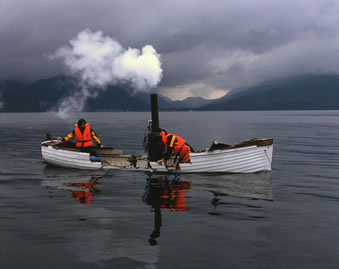The recent exhibition Zones de Productivités Concertées at the MAC/VAL in Paris featured a compelling ensemble of works by British born artist Simon Starling. The exhibition, subtitled Enterprises Singuliéres was the third and final installment in a series of group shows that collectively featured 20 “monographic exhibitions” that in some way engage notions of “the economy -its questions, its concepts, its thinking…”
Central to the collection of works exhibited by Starling in the exhibition was a recent film (2006) titled Autoxylopyrocycloboros. A somewhat unwieldy name for such an elegant and conceptually resolved work. The film meticulously shot on super 16mm, which seems to be the contemporary art moving image medium of choice at the moment, features two men in a boat navigating a picturesque mist-shrouded Scottish Loch. I assume that one of the men is the artist. The boat is an old wooden one powered by a fuel burning stove, the two men are hard at work sawing pieces of the boat away which in turn are used to fuel the engine that propels its passage. And so it goes until the boat finally starts taking on water and rather undramatically sinks.
To date Simon Starling’s practice has been pretty much defined by examining or making visible the processes behind the transformation of materials and objects from one state to another. The two other works included in the MAC/VAL show consisted of a series of deadpan photographs of a car that had been geographically relocated and mechanically modified and a collection of coins titled Home-Made 20 pence piece (anon) found in Glasgow on the 8th of January 1996 and reproduced in addition of 27 using the silver from on ladle produced by George Smith and William Fearn, circa 1830.
Within his work things move from one state to another. A boat becomes a boat in motion until the motion itself consumes the very integrity of the craft, the ability of the boat to stay afloat. It is not hard to read the work as a metaphor for the current economic/environmental predicament. One is left wondering at what point the world’s economy is at in its doomed cruise, seems that we are taking on a bit of water at the moment.
Rewatching Michelangelo Antonioni’s Deserto Rosso a few days later in a small cinema on the left bank (there has been a proliferation of tribute screenings in the wake of the director’s death) I was jolted into recognising the very same metaphor at work within the film, albeit alluding to a very different economy.

In Antonioni’s film a group of three couples gather in a secluded wharf side shack for a casual get-together that ambiguously veers towards an orgy. Exactly what transpires is never really divulged by the film’s elliptical narrative space. However, at some point in the proceedings the participants begin to pull planks from the walls of the shack and burn them in the small stove that heats the somewhat dank space. Despite the half-hearted protestations of the shack’s owner the group becomes ever more animated, smashing furniture and dismantling a brightly painted wall to use as fuel for the wood stove.

How then do we read these actions? It is tempting to view this spontaneous ritual of destruction in terms of the societal changes that were in 1964 about to sweep through the western world. But if we look closer to the narrative confines of the film itself we can see a much more interesting and complex web of meanings alluded to. A web in which the hinted transgressions and indiscretions of the proceeding scene resurface. A libidinal economy emerges that produces desire through the dismantling of its very supporting structures. An architecture of desire that is only made inhabitable by its own combustion.

